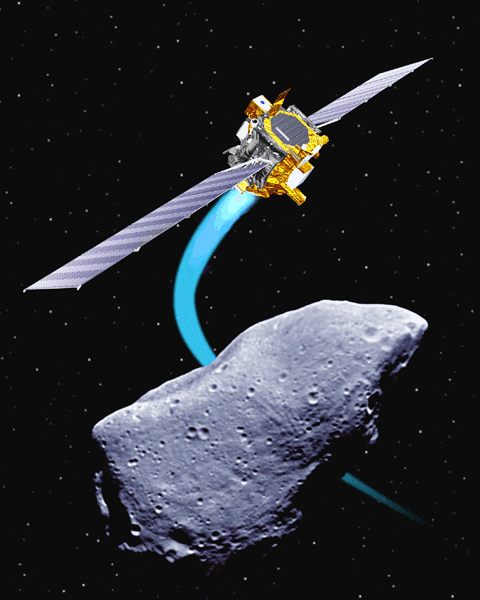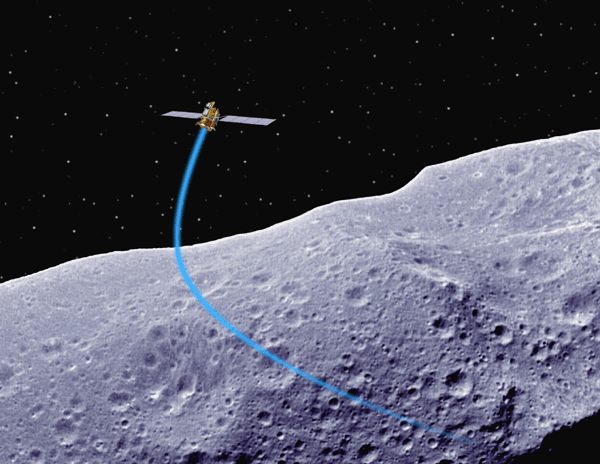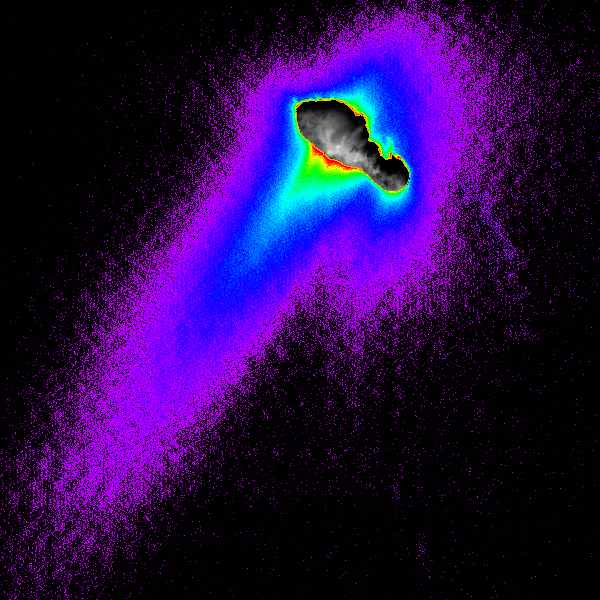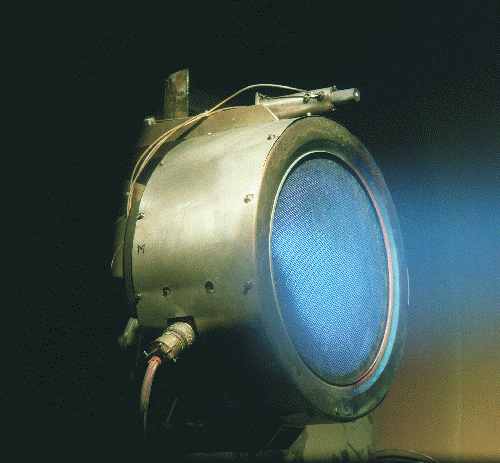COMETS SEEING FAMOUS EXPLORATION STARDUST ROSETTA DEEP IMPACT HALE-BOPP DEEP SPACE 1
DID A COMET BRING SARS TO EARTH? COULD A COMET HIT EARTH? COMET RESOURCES
 Deep Space 1 over Asteroid Braille click to enlarge NASA artist concept |
The small interplanetary probe tested a solar electric engine, an autonomous navigation system, and advanced microelectronics and telecommunications devices.
Launch. Deep Space 1 was blasted off from Cape Canaveral on October 24, 1998.
Primary mission of testing. Completing a successful primary mission, the probe tested twelve advanced technologies in space.
Extended mission of exploring. While testing new equipment, Deep Space 1 also was to contribute to human understanding of near-Earth asteroids and comets.
In a successful extended mission, Deep Space 1 flew away from Earth and encountered near-Earth asteroid 1992 KD on July 20, 1999.
|
||||||||||||
For the comet encounters, the goal was to find out the size, shape, surface features, brightness, mass, density, and spin state of the comets' nuclei.
Studies of the comets' comas included plasma properties, the interaction of the coma with the solar wind, brightness, and features of dust and gas jets emanating from the nucleus.
After that successful encounter with Comet Borrelly, Deep Space 1 was referred to in the press as "the little spacecraft that could."
Ion engines. Xenon – the gas used in plasma television sets, automobile headlights, and photo flash tubes – is used in ion engines.
Ion propulsion systems are lightweight, since they require only a few grams of xenon gas per day. While the thrust exerted by an ion engine is gentle, moving a spacecraft along slowly, the engine's fuel efficiency actually can reduce trip times and lower the cost of the launch vehicle. Those factors makes ion engines an attractive choice for future deep space missions.
Deep Space 1 was the first use of such an ion engine as the primary method of propulsion on a NASA spacecraft. The engine was operated for 16,265 hours in space – a record for any propulsion system out there.
EUROPE'S SMART-1 MOON PROBE HAS AN ION ENGINE
 Deep Space 1 ion engine click to enlarge NASA image |
The 1,071 lb. probe was designed and built in just three years and launched on October 24, 1998.
DS-1 tested twelve different new technologies in space including:
- the ion engine
- the autonomous navigation system that computed and corrected Deep Space 1's course without intervention of human controllers on Earth
- the solar array that concentrated sunlight for extra power
However, along the way, DS-1's star tracker failed. From back home on Earth, 185 million miles away, engineers successfully analyzed the problem, figured out a new way to pilot the spacecraft, and reprogrammed the probe's computer by radio.
It worked! On September 22, 2001, Deep Space 1 flew in to take the most detailed pictures of a comet nucleus up to that time. The images and other scientific data sent back to Earth from Comet Borrelly have been used by planetary scientists and interplanetary mission planners in preparing for future flights.
After the Borrelly fly by, NASA extended the DS-1 mission to put the spacecraft's experimental technologies through more demanding tests.
On December 18, 2001, after more than three years in space and two trips around the Sun, the Deep Space 1 controllers at JPL sent a final set of instructions. The spacecraft's radio transmitter was switched off and the groundbreaking Deep Space 1 mission ended. The spacecraft was, in effect, retired.
Comet Borrelly. Comets differ from asteroids, which have been heavily pockmarked by impact craters. Comets are a mixture of dust, ice and frozen gases. Their surfaces have features produced by the distilling of gases and ices as the Sun warms the comet during the small body's passage through the inner Solar System near the Sun.
The pictures received from Comet 19/P Borrelly were the clearest images to date of a comet. They showed features similar to the ridges, hills, depressions and mesas we see on Earth. There were no impact craters on Borrelly.
For instance, a mesa on Earth is a flat-topped, steep-sided hill capped by a strong layer of rock over a a weak layer of rock. A mesa is formed by erosion of the weaker lower layer. Examples are the mesas of Monument Valley in Arizona.
Similarly, Borrelly has a series of flat-topped, steep-sided hills in the central area of the comet near the most active regions. Scientists call those features mesas. They may have been formed in the same way mesas are formed on Earth. The top of a mesa on Borrelly has a thick insulating layer of dust, but the steep sides expose the underlying ice-rich comet material. Ices distill out the sides of the mesas, undercutting the thick, insulating layer and causing sections of it to collapse on the valley floor.
Borrelly is a tiny body only about 2.5 miles wide and 5 miles long. It appears to have been broken into two pieces at some time past. The lower part of the comet is tilted by about 15 degrees. It looks like the two sections chaff each other, forcing up ridges at their boundaries.
Jet Propulsion Lab. NASA's lead center for robot exploration of the Solar System – JPL – managed the Deep Space 1 mission for NASA's Office of Space Science at Washington, D.C. In turn, JPL itself is managed for NASA by the California Institute of Technology and is located on a 177-acre site at the foot of the San Gabriel Mountains near Pasadena, California, 12 miles northeast of Los Angeles.
Ion propulsion engine development was led by NASA's In-Space Propulsion Program managed by the Office of Space Science at NASA Headquarters and implemented by the In-Space Propulsion Program at Marshall Space Flight Center, Huntsville, Alabama, with NASA's Solar Electric Technology Application Readiness test team from JPL's Advanced Propulsion Technology Group, and contributions from NASA's Glenn Research Center at Cleveland, Ohio.
LEARN MORE ABOUT DEEP SPACE 1



